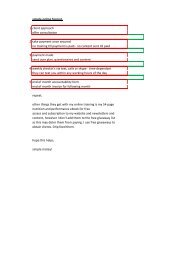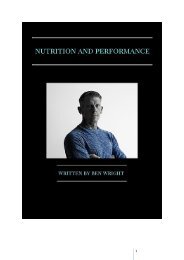Create successful ePaper yourself
Turn your PDF publications into a flip-book with our unique Google optimized e-Paper software.
Don’t stress however if one week your unable to make progress. It’s highly unlikely you will never<br />
get a week where you feel weaker <strong>and</strong> fatigue quicker. At this point evaluate whether it may be<br />
down to adequate rest, <strong>nutrition</strong> or over training. Perhaps you didn’t eat enough before your session<br />
or maybe your body needs some rest. In most cases just listen to your body <strong>and</strong> do what’s needed to<br />
help progression.<br />
Measuring body composition<br />
There are many ways to measure the body’s composition but if you mix up the three I’m about to list<br />
then you will be able to track things easily <strong>and</strong> effectively.<br />
<br />
<br />
<br />
Photos <strong>and</strong> the mirror<br />
Scales<br />
Callipers<br />
Photos <strong>and</strong> the mirror<br />
In my opinion the best way to see results is to take photos <strong>and</strong> look in the mirror. The mirror doesn’t<br />
lie!<br />
There will be cases where fat loss occurs whilst experiencing muscle growth. Therefore, you may not<br />
see specific changes on the scales. A simply change in body composition is what’s occurring. This<br />
happens quite often in people who have just taken up training, or teenagers etc. To be fair the more<br />
experienced lifters usually go for bulk <strong>and</strong> cut style training cycles as loosing fat <strong>and</strong> gaining muscle<br />
can be a long <strong>and</strong> drawn out process. Most people want quick results. However, you can “lean Bulk”<br />
by following a healthy diet <strong>and</strong> monitoring fat levels, making sure you don’t increase bodyfat to<br />
much.<br />
Taking pictures <strong>and</strong> looking in the mirror will allow you to take notice of your body <strong>and</strong> imagine how<br />
you would like yourself to look. Then comparing the pictures over time. Small changes are hard to<br />
notice. This can be frustrating. So, if you have taken pictures which you can compare six months<br />
down the line, you may be shocked by the progress.<br />
Scales<br />
A lot of people are either terrified of the scales or they are obsessed with the numbers on it.<br />
However, you can use them systematically without being dependant.<br />
It’s not unusual to have your weight fluctuate up <strong>and</strong> down over the weeks. Things like water<br />
retention <strong>and</strong> sodium levels can spike the scales a pound here <strong>and</strong> a pound there. If your stressed<br />
<strong>and</strong> tired then your body may respond by bloating etc. so the best way to measure your weight, <strong>and</strong><br />
this works for gaining <strong>and</strong> losing weight, is to weigh yourself each morning <strong>and</strong> write down the<br />
result. Do this for 1 week <strong>and</strong> add up the total <strong>and</strong> divide it by seven. Then the next week do the<br />
same again. What you do next is take the two results <strong>and</strong> compare the difference by subtracting the<br />
first week from the second. Hey presto that’s your weight loss approximate. Do this each week till<br />
your cutting or bulking phase is finished.<br />
You can also track your weight using my fitness pal. It will give you a chart showing the steady<br />
increase or decrease of weight for up to one year. It’s a great tool.<br />
Like I said your weight will fluctuate but if your sticking to your diet <strong>and</strong> training frequently then the<br />
general trend will be up or down.<br />
39




